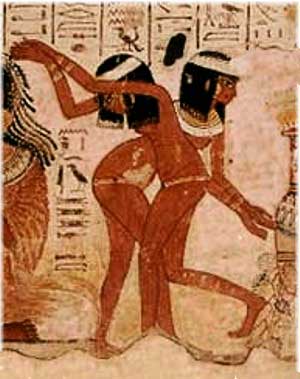
Egyptian art is famous for its distinctive figure convention, used for the main figures in both relief and painting, with parted legs (where not seated) and head shown as seen from the side, but the torso seen as from the front, and a standard set of proportions making up the figure, using 18 “fists” to go from the ground to the hair-line on the forehead.
Not all Egyptian reliefs were painted, and less prestigious works in tombs, temples and palaces were merely painted on a flat surface. Stone surfaces were prepared by whitewash, or if rough, a layer of coarse mud plaster, with a smoother gesso layer above; some finer limestones could take paint directly. Pigments were mostly mineral, chosen to withstand strong sunlight without fading. The binding medium used in painting remains unclear: egg tempera and various gums and resins have been suggested. It is clear that true fresco, painted into a thin layer of wet plaster, was not used. Instead the paint was applied to dried plaster, in what is called “fresco a secco” in Italian. After painting, a varnish or resin was usually applied as a protective coating, and many paintings with some exposure to the elements have survived remarkably well, although those on fully exposed walls rarely have. Small objects including wooden statuettes were often painted using similar techniques.
Many ancient Egyptian paintings have survived in tombs, and sometimes temples, due to Egypt’s extremely dry climate. The paintings were often made with the intent of making a pleasant afterlife for the deceased. The themes included journey through the afterworld or protective deities introducing the deceased to the gods of the underworld (such as Osiris). Some tomb paintings show activities that the deceased were involved in when they were alive and wished to carry on doing for eternity.
In the New Kingdom and later, the Book of the Dead was buried with the entombed person. It was considered important for an introduction to the afterlife.Egyptian paintings are painted in such a way to show a profile view and a side view of the animal or person at the same time. For example, the painting to the right shows the head from a profile view and the body from a frontal view. Their main colors were red, blue, green, gold, black and yellow.Paintings showing scenes of hunting and fishing can have lively close-up landscape backgrounds of reeds and water, but in general Egyptian painting did not develop a sense of depth, and neither landscapes nor a sense of visual perspective are found, the figures rather varying in size with their importance rather than their location.

